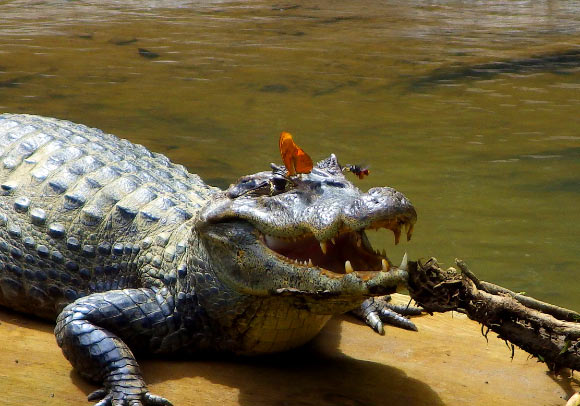Some species of bees and butterflies enjoy an occasional taste of crocodile tears, according to Dr Carlos de la Rosa from the La Selva Biological Station for the Organization for Tropical Field Studies in San Pedro, Costa Rica.

A Julia butterfly and a solitary bee sip tears from the eyes of spectacled caiman on Costa Rica’s Puerto Viejo River. Image credit: Carlos de la Rosa.
In December 2013, Dr de la Rosa observed a Julia butterfly (Dryas iulia) and a solitary bee (Centris sp.) along with a spectacled caiman (Caiman crocodilus) basking on the banks of the Río Puerto Viejo in northeastern Costa Rica.
The insects were simultaneously engaged in tear-feeding (lachryphagous) behavior. The caiman remained passive during the interactions, which Dr de la Rosa filmed for about 15 min.
“It was one of those natural history moments that you long to see up close,” said Dr de la Rosa, who reported this case in the journal Frontiers in Ecology and the Environment (full article in .pdf)
“But then the question becomes, what’s going on in here? Why are these insects tapping into this resource?”
“The butterfly and the bee were most likely seeking minerals and an extra boost of protein.”
Dr de la Rosa had seen butterflies and moths in the Amazon feeding on the tears of turtles and a few caimans. Lachryphagous behavior in bees had only recently been observed by biologists.
Back at the field station, Dr de la Rosa was surprised to find more evidence of such behavior than he expected in the collective online record of wilderness enthusiasts, casual tourists, professional photographers, and scientists.
“The phenomenon may not be as rare as biologists had assumed – just hard to witness,” he said.
“I did a Google search for images and I found out that it is quite common! A lot of people have recorded butterflies, and some bees, doing this.”
“This experience reminds us that the world still has many surprises for ecologists,” Dr de la Rosa concluded.
______
Carlos L de la Rosa 2014. Additional observations of lachryphagous butterflies and bees. Frontiers in Ecology and the Environment 12: 210–210; doi: 10.1890/14.WB.006







